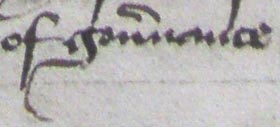|
| A |
 | Usage: and
both single and double compartment 'a' are used. The hand is very variable with preferences for different forms of graph depending on stint. |  | Usage: hath
an oval version of the single compartment. |
 | Usage: And |  | Usage: As |
|
| D |
 | Usage: deth
'd' is always looped with a very angular bowl although a rounder version is also used at times. |  | Usage: groundid
angular and rounded in one word. |
 | Usage: Hadde |  | Usage: Dede
the upper case version. |
|
| G |
 | Usage: youre gude
'g' is tailed and the tail extends backwards under several graphs in a curve. |  | Usage: kyng |
 | Usage: Rightwisnesse |  | Usage: of gou(er)nance
on the bottom line of the folio hence the licence to curve the tail counter-clockwise at the end, as well as avoiding the descender of 'f'. |
|
| H |
 | Usage: hath
'h' is consistently neat. |  | Usage: deth
'h' after 't' or 'g' in final position is usually crossed. |
 | Usage: right |  | Usage: Hadde
upper case 'H' at the beginning of a line. Note the extra loop to the left of the stem. |
|
| R |
 | Usage: riche
all forms of 'r' are used, again according to stint. 'r' in initial position may be modern 'r', long 'r' or even 'z'-shaped 'r', see version 3. |  | Usage: declar(e)
'r' in final position may also be either long 'r' or modern 'r'. Here long 'r' with flourish to represent a missing 'e'. |
 | Usage: rich
'z'-shaped 'r' in initial position. |  | Usage: Ryght
a very angular form of the upper case graph. |
|
| S |
 | Usage: swich
either sigma or long 's' is used in initial position. |  | Usage: Epistles
kidney-shaped 's' is usually used in final position. |
 | Usage: sitten
occasionally the head-stroke of long 's' extends over the top of several succeeding graphs. |  | Usage: Stoppith |
|
| W |
 | Usage: wiche
'w' also comes in variety. Here a simple looped version which is basically two 'v's.. |  | Usage: wittes
this 'w' alternates with version 1 to no apparent pattern. |
 | Usage: What
found at the beginning of a stanza and with rather exaggerated head-strokes. Notice the foot at the base of the initial stroke and the 'B'-shaped element at the right. |  | Usage: Whos
'W' at the beginning of a line. |
|
| Y |
 | Usage: myghty
the shape of the body of 'y' varies little. The tail may be thin, thick, curved or straight. |  | Usage: y |
 | Usage: youre |  | Usage: may
a very fine oblique stroke as the tail. |
|
| Thorn |
 | Usage: þe
thorn is used frequently. It is used for the usual articles and adjectives but also as a replacement 'th' in places. |  | Usage: Þogh
what may be the scribe's upper case 'Thorn' at the beginning of a line. An exggerated hook as an approach stroke and two dots at the left of the shaft |
 | Usage: worþinesse
the stem of thorn is very thick and tapers as it descends. |  | Usage: þerynne
the lobe of thorn is small in comparison with the length and thickness of the stem. |
|
| Upper Case Letters |
 | Usage: Iuge
'I' is distinctive and may be traced throughout the manuscript although the hand varies at times. |  | Usage: But |
 | Usage: To |  | Usage: Of |










































